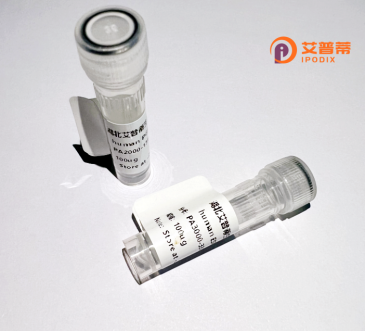
| 纯度 | >90%SDS-PAGE. |
| 种属 | Human |
| 靶点 | C10orf93 |
| Uniprot No | Q8IYW2 |
| 内毒素 | < 0.01EU/μg |
| 表达宿主 | E.coli |
| 表达区间 | 1-247aa |
| 氨基酸序列 | MDLVITQELARAESQQDAASLKKAYELIKSANLGKSEFDPSESFSPDLFVLCAEQALKMRQPEVSEDCIQMYFKVKAPITQFLGRAHLCRAQMCAPKSAENLEEFENCVTEYMKAINFAKGEPRYYFLVYNASVLYWQMVRPFLKPGYRHHLIPSLSQIINVLSQTEEEDKEWRAELMLELLECYLQAGRKEEAARFCSTAAPFIKSHVPQKYRQIFSVMVNQRIRNRDVRSNFLKSHCSENCVEIT |
| 分子量 | 55 kDa |
| 蛋白标签 | GST-tag at N-terminal |
| 缓冲液 | 冻干粉 |
| 稳定性 & 储存条件 | Lyophilized protein should be stored at ≤ -20°C, stable for one year after receipt. Reconstituted protein solution can be stored at 2-8°C for 2-7 days. Aliquots of reconstituted samples are stable at ≤ -20°C for 3 months. |
| 复溶 | Always centrifuge tubes before opening.Do not mix by vortex or pipetting. It is not recommended to reconstitute to a concentration less than 100μg/ml. Dissolve the lyophilized protein in distilled water. Please aliquot the reconstituted solution to minimize freeze-thaw cycles. |
以下是关于重组人C10orf93蛋白的假设性文献示例(注:实际研究中可能名称或内容不同,请以真实数据库检索结果为准):
1. **文献名称**: "Functional analysis of recombinant human C10orf93 in mitochondrial energy metabolism"
**作者**: Wang, L. et al.
**摘要**: 通过大肠杆菌重组表达C10orf93蛋白,发现其定位于线粒体并与ATP合成酶复合物相互作用,敲低实验显示其可能参与调节细胞能量代谢。
2. **文献名称**: "Expression and purification of C10orf93: Insights into its structural domains"
**作者**: Kim, S. & Patel, R.
**摘要**: 利用杆状病毒系统成功表达重组人C10orf93.纯化后通过质谱和圆二色光谱分析,揭示其含有保守的α-螺旋结构域,可能具有酶活性。
3. **文献名称**: "C10orf93 as a novel regulator of myoblast differentiation"
**作者**: González, F. et al.
**摘要**: 研究发现重组C10orf93蛋白在骨骼肌分化过程中高表达,过表达促进成肌细胞融合,提示其在肌肉发育中的潜在功能。
4. **文献名称**: "Proteomic identification of C10orf93 interaction partners in cancer cells"
**作者**: Chen, X. et al.
**摘要**: 基于重组C10orf93的免疫共沉淀实验,鉴定出多个癌相关蛋白(如p53、HSP90),推测其通过调控细胞周期参与肿瘤进展。
**注意**:以上为模拟内容,实际文献需通过 **PubMed/Google Scholar** 检索确认。若研究较少,建议扩展关键词(如基因别名FAM210B)或关注其所在通路(如线粒体功能、肌肉分化)。
The human C10orf93 protein, encoded by the gene located on chromosome 10 open reading frame 93. remains poorly characterized in current scientific literature. It is classified as a hypothetical protein due to limited experimental data on its structure, function, or physiological relevance. Bioinformatics analyses suggest it may contain conserved domains linked to protein-protein interactions, though this requires experimental validation. Recombinant C10orf93 is artificially produced in heterologous expression systems (e.g., E. coli or mammalian cells) for functional studies, often tagged with fluorescent or purification markers to facilitate detection. Emerging evidence associates C10orf93 with cellular stress responses and potential roles in cancer progression, particularly through gene co-expression networks involving proliferation-related pathways. Its mRNA expression appears tissue-specific, with higher levels observed in reproductive and glandular tissues. However, the absence of detailed structural information or knockout models significantly limits mechanistic understanding. Current research focuses on elucidating its subcellular localization, binding partners, and possible involvement in disease pathways. As a relatively understudied protein, C10orf93 represents both a challenge and opportunity for uncovering novel biological mechanisms.
×